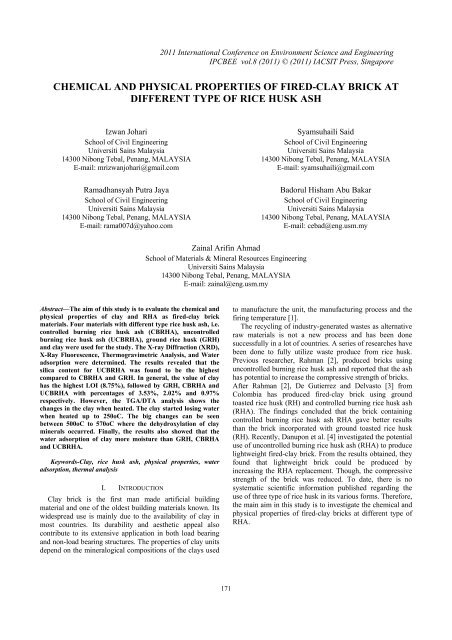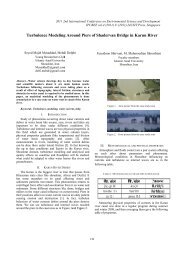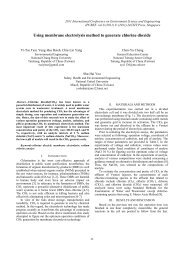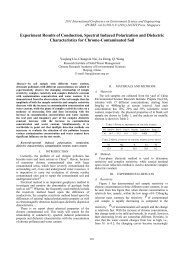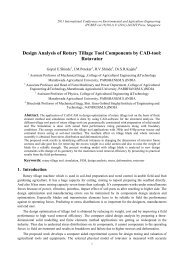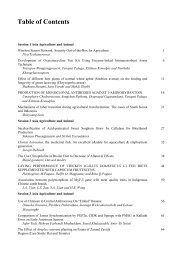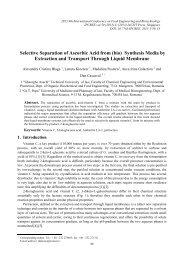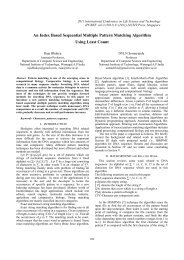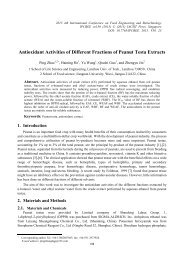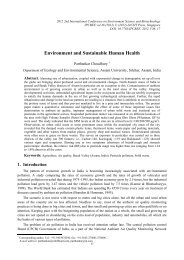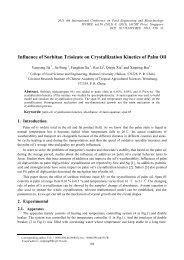Chemical and physical properties of fired-clay brick - ipcbee
Chemical and physical properties of fired-clay brick - ipcbee
Chemical and physical properties of fired-clay brick - ipcbee
You also want an ePaper? Increase the reach of your titles
YUMPU automatically turns print PDFs into web optimized ePapers that Google loves.
CHEMICAL AND PHYSICAL PROPERTIES OF FIRED-CLAY BRICK AT<br />
DIFFERENT TYPE OF RICE HUSK ASH<br />
Izwan Johari<br />
School <strong>of</strong> Civil Engineering<br />
Universiti Sains Malaysia<br />
14300 Nibong Tebal, Penang, MALAYSIA<br />
E-mail: mrizwanjohari@gmail.com<br />
Ramadhansyah Putra Jaya<br />
School <strong>of</strong> Civil Engineering<br />
Universiti Sains Malaysia<br />
14300 Nibong Tebal, Penang, MALAYSIA<br />
E-mail: rama007d@yahoo.com<br />
Abstract—The aim <strong>of</strong> this study is to evaluate the chemical <strong>and</strong><br />
<strong>physical</strong> <strong>properties</strong> <strong>of</strong> <strong>clay</strong> <strong>and</strong> RHA as <strong>fired</strong>-<strong>clay</strong> <strong>brick</strong><br />
materials. Four materials with different type rice husk ash, i.e.<br />
controlled burning rice husk ash (CBRHA), uncontrolled<br />
burning rice husk ash (UCBRHA), ground rice husk (GRH)<br />
<strong>and</strong> <strong>clay</strong> were used for the study. The X-ray Diffraction (XRD),<br />
X-Ray Fluorescence, Thermogravimetric Analysis, <strong>and</strong> Water<br />
adsorption were determined. The results revealed that the<br />
silica content for UCBRHA was found to be the highest<br />
compared to CBRHA <strong>and</strong> GRH. In general, the value <strong>of</strong> <strong>clay</strong><br />
has the highest LOI (8.75%), followed by GRH, CBRHA <strong>and</strong><br />
UCBRHA with percentages <strong>of</strong> 3.53%, 2.02% <strong>and</strong> 0.97%<br />
respectively. However, the TGA/DTA analysis shows the<br />
changes in the <strong>clay</strong> when heated. The <strong>clay</strong> started losing water<br />
when heated up to 250oC. The big changes can be seen<br />
between 500oC to 570oC where the dehydroxylation <strong>of</strong> <strong>clay</strong><br />
minerals occurred. Finally, the results also showed that the<br />
water adsorption <strong>of</strong> <strong>clay</strong> more moisture than GRH, CBRHA<br />
<strong>and</strong> UCBRHA.<br />
Keywords-Clay, rice husk ash, <strong>physical</strong> <strong>properties</strong>, water<br />
adsorption, thermal analysis<br />
I. INTRODUCTION<br />
Clay <strong>brick</strong> is the first man made artificial building<br />
material <strong>and</strong> one <strong>of</strong> the oldest building materials known. Its<br />
widespread use is mainly due to the availability <strong>of</strong> <strong>clay</strong> in<br />
most countries. Its durability <strong>and</strong> aesthetic appeal also<br />
contribute to its extensive application in both load bearing<br />
<strong>and</strong> non-load bearing structures. The <strong>properties</strong> <strong>of</strong> <strong>clay</strong> units<br />
depend on the mineralogical compositions <strong>of</strong> the <strong>clay</strong>s used<br />
2011 International Conference on Environment Science <strong>and</strong> Engineering<br />
IPCBEE vol.8 (2011) © (2011) IACSIT Press, Singapore<br />
Zainal Arifin Ahmad<br />
School <strong>of</strong> Materials & Mineral Resources Engineering<br />
Universiti Sains Malaysia<br />
14300 Nibong Tebal, Penang, MALAYSIA<br />
E-mail: zainal@eng.usm.my<br />
171<br />
Syamsuhaili Said<br />
School <strong>of</strong> Civil Engineering<br />
Universiti Sains Malaysia<br />
14300 Nibong Tebal, Penang, MALAYSIA<br />
E-mail: syamsuhaili@gmail.com<br />
Badorul Hisham Abu Bakar<br />
School <strong>of</strong> Civil Engineering<br />
Universiti Sains Malaysia<br />
14300 Nibong Tebal, Penang, MALAYSIA<br />
E-mail: cebad@eng.usm.my<br />
to manufacture the unit, the manufacturing process <strong>and</strong> the<br />
firing temperature [1].<br />
The recycling <strong>of</strong> industry-generated wastes as alternative<br />
raw materials is not a new process <strong>and</strong> has been done<br />
successfully in a lot <strong>of</strong> countries. A series <strong>of</strong> researches have<br />
been done to fully utilize waste produce from rice husk.<br />
Previous researcher, Rahman [2], produced <strong>brick</strong>s using<br />
uncontrolled burning rice husk ash <strong>and</strong> reported that the ash<br />
has potential to increase the compressive strength <strong>of</strong> <strong>brick</strong>s.<br />
After Rahman [2], De Gutierrez <strong>and</strong> Delvasto [3] from<br />
Colombia has produced <strong>fired</strong>-<strong>clay</strong> <strong>brick</strong> using ground<br />
toasted rice husk (RH) <strong>and</strong> controlled burning rice husk ash<br />
(RHA). The findings concluded that the <strong>brick</strong> containing<br />
controlled burning rice husk ash RHA gave better results<br />
than the <strong>brick</strong> incorporated with ground toasted rice husk<br />
(RH). Recently, Danupon et al. [4] investigated the potential<br />
use <strong>of</strong> uncontrolled burning rice husk ash (RHA) to produce<br />
lightweight <strong>fired</strong>-<strong>clay</strong> <strong>brick</strong>. From the results obtained, they<br />
found that lightweight <strong>brick</strong> could be produced by<br />
increasing the RHA replacement. Though, the compressive<br />
strength <strong>of</strong> the <strong>brick</strong> was reduced. To date, there is no<br />
systematic scientific information published regarding the<br />
use <strong>of</strong> three type <strong>of</strong> rice husk in its various forms. Therefore,<br />
the main aim in this study is to investigate the chemical <strong>and</strong><br />
<strong>physical</strong> <strong>properties</strong> <strong>of</strong> <strong>fired</strong>-<strong>clay</strong> <strong>brick</strong>s at different type <strong>of</strong><br />
RHA.
II. MATERIALS<br />
There are four basic materials involved in the study: <strong>clay</strong>,<br />
controlled burning rice husk ash (CBRHA), uncontrolled<br />
burning rice husk ash (UCBRHA) <strong>and</strong> ground rice husk<br />
(GRH), In this investigation, the <strong>clay</strong> was wet <strong>and</strong> in large<br />
chunk. Then, exposed to ambient sun dried at temperature<br />
35 o C for 7 days. On the other h<strong>and</strong>, the rice husk ash was<br />
generated after burning rice husk at 700 o C for 6 hours in a<br />
muffle furnace model Carbolite CWF 1400. Fully burnt<br />
RHA was white with grey while partially burnt RHA was<br />
grey with black particles. The produced RHA was stored in a<br />
closed container <strong>and</strong> kept in a dry place.<br />
The second replacement material is a waste rice husk ash<br />
(uncontrolled burning). The husk was partially burnt by selfburning<br />
from a steam boiler. The ash was grey with black<br />
particles all over it <strong>and</strong> it was dumped in an open area. The<br />
black particles are the partially burnt rice husk. This<br />
UCBRHA was collected directly from the steam boiler<br />
discharge pipeline. It was packed in a 50kg sack, stored in a<br />
closed container <strong>and</strong> kept in a dry place. The third<br />
replacement material is GRH. Rice husks from the rice mill<br />
company were milled using a fabricated ring mill machine<br />
<strong>and</strong> steel ring. The husks were ground to the required particle<br />
size. The produced GRH was stored in a closed container<br />
<strong>and</strong> kept in a dry place.<br />
III. METHODS<br />
A. X-Ray Fluorescence Method<br />
This test was carried out to determine the chemical<br />
composition <strong>of</strong> <strong>clay</strong>, GRH, CBRHA <strong>and</strong> UCBRHA. The<br />
apparatus used in this study was RIGAKU RIX3000.<br />
However, Loss on ignition (LOI) value for the sample was<br />
determined separately.<br />
B. X-ray Diffraction (XRD)<br />
In this investigation, the raw materials were analyzed by<br />
XRD instrument named BRUKER AXS D8 ADVANCE.<br />
Small amount <strong>of</strong> sample was place on the sample holder<br />
then directly taken to characterize. XRD patterns were<br />
scanned in steps <strong>of</strong> 0.0034 o in a range <strong>of</strong> diffraction angle<br />
from 5 o to 70 o <strong>of</strong> 2θ, using Copper (Cu) as X-ray source<br />
with wavelength (λ) <strong>of</strong> 1.5406 nm.<br />
C. Thermal Analysis<br />
The simultaneous <strong>of</strong> Thermogravimetric Analysis (TGA)<br />
<strong>and</strong> Differential Thermal Analysis (DTA) was used in this<br />
study. Thermogravimetric analysis <strong>and</strong> Differential Thermal<br />
Analysis were applied in order to observe the reactions<br />
taking place during the thermal treatment <strong>of</strong> the samples.<br />
The analysis was carried out using NETZECH Model STA<br />
409 PC LUXX. At the specified testing, a total <strong>of</strong> 20 - 25<br />
mg <strong>of</strong> the samples were taken in a platinum pan <strong>and</strong> heated<br />
in nitrogen atmosphere at a temperature range between 20 to<br />
1100°C with controlled heating rate 10°C/min.<br />
172<br />
D. Water adsorption<br />
In this test, the samples were placed inside a porcelain<br />
crucible <strong>and</strong> then dried in an oven at a temperature <strong>of</strong> 105 o C<br />
for 24 hours to obtain the dry weight. The samples were<br />
weighed using an electronic analytical balance model A&D<br />
HM300 that can be readable up to 0.001g. The adsorption <strong>of</strong><br />
material (total water adsorption) is defined as the increase in<br />
the weight <strong>of</strong> a material due to moisture in air, <strong>and</strong> can be<br />
calculated using equation 1.<br />
( )<br />
( ) 100<br />
W b − W a<br />
W − W<br />
W % =<br />
×<br />
(1)<br />
a<br />
c<br />
Where: W is moisture content <strong>of</strong> specimen (%), Wa is<br />
weight <strong>of</strong> specimen after oven dried for 24 hours (g), Wb is<br />
weight <strong>of</strong> specimen after 24 hours in desiccators (g), <strong>and</strong> Wc<br />
is weight <strong>of</strong> crucible (g).<br />
IV. RESULTS AND DISCUSSION<br />
A. <strong>Chemical</strong> composition<br />
Table 1 presents the tabulation <strong>of</strong> the chemical<br />
composition for <strong>clay</strong> <strong>and</strong> rice husk ash. Indicates that<br />
UCBRHA has the highest amount <strong>of</strong> silica (93%), followed<br />
by CBRHA (88%), <strong>clay</strong> (67%), <strong>and</strong> GRH (11%). The silica<br />
in <strong>clay</strong> is present in a different form as a free form (SiO2)<br />
<strong>and</strong> in the form <strong>of</strong> compounds when mixed with other<br />
elements such as aluminium oxide (Al2O3) to form kaolinite<br />
(Al2(Si2O5)(OH)4) in the feldspar group. The element that<br />
contributes to the red colour <strong>of</strong> <strong>clay</strong> is iron oxide (Fe2O3).<br />
The colour is not dominant due to the presence <strong>of</strong> other<br />
materials inside raw <strong>clay</strong> such as organic matters that make<br />
raw <strong>clay</strong> grey, black, or dark brown depending on the<br />
amount present. However, the colour changes after the<br />
firing process when carbonaceous material <strong>and</strong> iron<br />
compounds start to oxidize [5].<br />
TABLE I. CHEMICAL COMPOSITIONS OF CLAY AND RICE HUSK ASH<br />
Component (%) Clay CBRHA UCBRHA GRH<br />
SiO2 67.000 88.000 93.000 11.000<br />
Al2O3 26.000 0.130 0.260 0.230<br />
Fe2O3 2.900 0.099 0.100 0.340<br />
Na2O 0.069 - 0.052 -<br />
MgO 1.200 1.800 0.490 0.580<br />
P2O5 0.036 3.300 0.670 2.000<br />
SO3 0.470 1.000 0.025 0.830<br />
Cl Trace 0.250 0.011 0.240<br />
K2O 2.100 4.700 1.100 1.900<br />
CaO 0.110 0.720 0.380 0.400<br />
Cr2O3 0.012 - - -<br />
MnO 0.010 - 0.029 0.130<br />
NiO Trace Trace Trace Trace<br />
CuO Trace Trace Trace Trace
ZnO Trace - Trace 0.028<br />
Br - Trace Trace -<br />
C - Trace 3.000 82.000<br />
B. Phase identification<br />
The controlled burning rice husk ash (CBRHA) was<br />
amorphous silica as illustrated in Figure 1. The difference<br />
between the amorphous <strong>and</strong> crystalline phase is that the<br />
amorphous has a broad peak <strong>and</strong> a wide angle <strong>of</strong> 2θ, while<br />
the crystalline phase has a pattern <strong>and</strong> a sharp peak. The<br />
crystalline peak can be seen in Figure 2, where the peak has<br />
a pattern <strong>and</strong> is not broad.<br />
Lin (Counts)<br />
Lin (Counts)<br />
1000<br />
900<br />
800<br />
700<br />
600<br />
500<br />
400<br />
300<br />
200<br />
100<br />
0<br />
4000<br />
3000<br />
2000<br />
1000<br />
0<br />
10 20 30 40 50 60 70 80 9<br />
2-Theta - Scale<br />
cbrha - File: CBRHA.RAW - Type: 2Th/Th locked - Start: 10.000 ° - End: 90.012 ° - Step: 0.034 ° - Step time: 71.6 s - Temp.: 25 °C (Room) - Time Started: 10 s - 2-Theta: 10.000 ° - Theta: 5.000 ° - Chi: 0.00 ° - Phi: 0.00 ° - X: 0.0 mm - Y: 0.0 mm - Z: 0.<br />
Operations: Background 1.000,1.000 | Import<br />
Figure 1. XRD <strong>of</strong> Controlled Burning Rice Husk Ash (CBRHA)<br />
10 20 30 40 50 60 70 80 9<br />
2-Theta - Scale<br />
ucbrha - File: ucbrha.raw - Type: 2Th/Th locked - Start: 10.000 ° - End: 90.012 ° - Step: 0.034 ° - Step time: 71.6 s - Temp.: 25 °C (Room) - Time Started: 10 s - 2-Theta: 10.000 ° - Theta: 5.000 ° - Chi: 0.00 ° - Phi: 0.00<br />
Operations: Background 1.000,1.000 | Import<br />
01-082-1403 (C) - Cristobalite beta, syn - SiO2 - Y: 117.29 % - d x by: 1. - WL: 1.5406 - Tetragonal - a 4.97800 - b 4.97800 - c 6.93210 - alpha 90.000 - beta 90.000 - gamma 90.000 - Primitive - P41212 (92) - 4 - 171.7<br />
Figure 2. XRD <strong>of</strong> Uncontrolled Burning Rice Husk Ash (UCBRHA)<br />
C. Thermal Analysis<br />
The effect <strong>of</strong> heat on the <strong>clay</strong> was initially studied using<br />
TG-DTA analysis as shown in Figure 3. The initial weight<br />
<strong>of</strong> the sample was 69.000 mg, which was reduced to 68.011<br />
mg at the lowest point at 658.8 o C. The TG-DTA analysis<br />
curve shows the changes in the <strong>clay</strong> when heated. The <strong>clay</strong><br />
173<br />
started losing water when it was heated up to 250 o C. The<br />
big changes can be seen between 500 o C to 570 o C where the<br />
dehydroxylation <strong>of</strong> <strong>clay</strong> minerals occurred. The effect <strong>of</strong><br />
fluxes components such as K2O, Na2O <strong>and</strong> CaO, could be<br />
seen when the <strong>clay</strong> started to have a reaction that began<br />
around 900 o C. This also marks the beginning <strong>of</strong> the<br />
sintering process for the <strong>clay</strong> <strong>and</strong> also as the starting point to<br />
select temperature range to determine optimum firing<br />
temperature.<br />
Figure 3. Thermogravimetric analysis <strong>of</strong> <strong>clay</strong><br />
D. Loss on ignition (LOI)<br />
Table 2 summarized the value loss on ignition for the<br />
raw material. This value is important to indicate the loss<br />
during the firing <strong>of</strong> the <strong>fired</strong>-<strong>clay</strong> <strong>brick</strong>. Based on the Table,<br />
the value <strong>of</strong> <strong>clay</strong> has the highest LOI (8.75%), followed by<br />
GRH, CBRHA <strong>and</strong> UCBRHA with percentages <strong>of</strong> loss <strong>of</strong><br />
3.53%, 2.02% <strong>and</strong> 0.97% respectively. High LOI value is<br />
because <strong>clay</strong> in nature contained more water in it grains <strong>and</strong><br />
it’s evaporate during the LOI test.<br />
According to Rahman [2] reported that the loss on<br />
ignition for <strong>clay</strong> as 8.35% <strong>and</strong> RHA as 3.59%. However,<br />
CBRHA value is higher than UCBRHA is due to condition<br />
during the LOI test. CBRHA was produced in control<br />
condition where the temperature was 700 o C. When the<br />
temperature <strong>of</strong> 1000 o C was applied during the LOI test, it<br />
will undergo changes in phase from amorphous to<br />
crystalline <strong>and</strong> some <strong>of</strong> volatile compound will evaporate.<br />
Compared to UCBRHA, it was produce from factory steam<br />
boiler where the temperature used was 1000 o C. When the<br />
temperature <strong>of</strong> 1000 o C was applied to it, this crystalline<br />
phase RHA was in stable condition <strong>and</strong> only carbon will<br />
evaporate during the test.<br />
TABLE II. LOSS ON IGNITION FOR CLAY AND REPLACEMENT<br />
MATERIALS<br />
Material Clay CBRHA UCBRHA GRH<br />
LOI (%) 8.75 2.02 0.97 3.53
E. Water adsorption for <strong>clay</strong>, CBRHA, UCBRHA <strong>and</strong> GRH<br />
Figure 4 represents a graphical illustration <strong>of</strong> moisture<br />
adsorption for all materials. Indicate that <strong>clay</strong> adsorbs more<br />
moisture than other material, with an adsorption value <strong>of</strong><br />
0.9981g, followed by GRH with 0.9337g, CBRHA with<br />
0.2644g <strong>and</strong> UCBRHA with 0.1475g. The second highest<br />
water adsorption is GRH. This is because raw rice husks<br />
contain about 50% cellulose, 20-30% lignin <strong>and</strong> 15-20%<br />
silica [6]. Conversely, when the rice husk is heated, the water<br />
inside the cellulose <strong>and</strong> lignin will dry up <strong>and</strong> cause a loss in<br />
mass [7]. These rice husks can absorb water significantly<br />
because <strong>of</strong> its hydrophilic characteristics [8]. Furthermore,<br />
these rice husks have been ground which increases its<br />
surface area. This could lead to an increase in the amount <strong>of</strong><br />
water absorbed compared to unground rice husks.<br />
Adsorption (g)<br />
1.2000<br />
1.0000<br />
0.8000<br />
0.6000<br />
0.4000<br />
0.2000<br />
0.0000<br />
0.9981<br />
0.9337<br />
0.5256<br />
0.2644<br />
0.1475<br />
<strong>clay</strong> GRH Unground RH CBRHA UCBRHA<br />
Figure 4. Results <strong>of</strong> water adsorption for <strong>clay</strong>, GRH, unground RH,<br />
CBRHA <strong>and</strong> UCBRHA<br />
V. CONCLUSION<br />
An experimental study was conducted to investigate the<br />
influence <strong>of</strong> chemical <strong>and</strong> <strong>physical</strong> <strong>properties</strong> <strong>of</strong> <strong>fired</strong>-<strong>clay</strong><br />
<strong>brick</strong> at different type rice husk ash. The following<br />
conclusions can be drawn:<br />
a. The silica (SiO2) content for UCBRHA was found to be<br />
the highest compared to CBRHA <strong>and</strong> GRH. However,<br />
the setback for this material is that the carbon content<br />
detected in UCBRHA could lead to a porous structure.<br />
174<br />
b. The TG-DTA analysis shows the changes in the <strong>clay</strong><br />
when heated. The <strong>clay</strong> started losing water when heated<br />
up to 250 o C. The big changes can be seen between<br />
500 o C to 570 o C where the dehydroxylation <strong>of</strong> <strong>clay</strong><br />
minerals occurred.<br />
c. Based on the results LOI, the value <strong>of</strong> <strong>clay</strong> has the<br />
highest LOI (8.75%), followed by GRH, CBRHA <strong>and</strong><br />
UCBRHA with percentages <strong>of</strong> 3.53%, 2.02% <strong>and</strong><br />
0.97% respectively. High LOI value is because <strong>clay</strong> in<br />
nature contained more water in it grains <strong>and</strong> it’s<br />
evaporate during the LOI test.<br />
d. The water adsorption <strong>of</strong> <strong>clay</strong> more moisture than other<br />
material, with an adsorption value <strong>of</strong> 0.9981g, followed<br />
by GRH with 0.9337g, CBRHA with 0.2644g <strong>and</strong><br />
UCBRHA with 0.1475g. Generally, The second highest<br />
water adsorption is GRH.<br />
ACKNOWLEDGMENT<br />
The support provided by Universiti Sains Malaysia in<br />
the form <strong>of</strong> a research grant for this study is very much<br />
appreciated.<br />
REFERENCES<br />
[1] A.W. Hendry, Reinforced <strong>and</strong> Prestressed Concrete. Longman<br />
Scientific <strong>and</strong> Technical, John Wiley &Sons, Inc., New York. 1991.<br />
[2] M.A. Rahman, “Effect <strong>of</strong> Rice Husk Ash on the Properties <strong>of</strong> Bricks<br />
Made from Fired Lateritic Soil-Clay Mix”, Material <strong>and</strong> Structures,<br />
Vol. 21, 1988, p. 222-227.<br />
[3] R.M. De Gutierrez, <strong>and</strong>, S. Delvasto, “Use <strong>of</strong> Rice Husk in Ceramic<br />
Bricks”, Ceramurgia, Vol. 25, 1995, p. 1-11.<br />
[4] T. Danupon, T. Perapong, <strong>and</strong> J. Sarawut, “Effects <strong>of</strong> Rice Husk Ash<br />
on Characteristics <strong>of</strong> Lightweight Clay Brick”, Proc. Technology <strong>and</strong><br />
Innovation for Sustainable Development Conference, Faculty <strong>of</strong><br />
Engineering, Khon Kaen University, Thail<strong>and</strong>, 2008, p. 36-39.<br />
[5] P.M. Rice, “Pottery Analysis”, The University <strong>of</strong> Chicago Press:<br />
1987, Chicago <strong>and</strong> London.<br />
[6] A.M. Waliuddin, <strong>and</strong> M.S. Ismail, “Effect <strong>of</strong> Rice Husk Ash on High<br />
Strength Concrete”, Journal <strong>of</strong> Construction <strong>and</strong> Building Materials,<br />
Vol. 10, 1996, p. 521-526.<br />
[7] M.A. Zezzi Arruda, C.S. Teixeira Tarley, <strong>and</strong> S.F. Costa Ferreira,.<br />
“Use <strong>of</strong> Modified Rice Husks as a Natural Solid Adsorbent <strong>of</strong> Trace<br />
Metals: Characterisation <strong>and</strong> Development <strong>of</strong> an On-line<br />
Preconcentration System for Cadmium <strong>and</strong> Lead Determination by<br />
FAAS”, Micro-chemical Journal, Vol. 77, 2004, p. 163– 175.<br />
[8] J. Prachayawarakorn, <strong>and</strong> N. Yaembunying, “Effect <strong>of</strong> Recycling on<br />
Properties <strong>of</strong> Rice Husk-Filled-Polypropylene”, Songklanakarin<br />
Journal Science Technology, Vol. 27 (2), 2005, p. 343-352.


